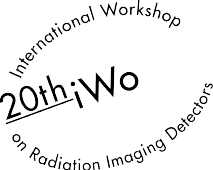Speaker
Description
Direct imaging detectors have improved the quality of data acquisition for single particle electron cryo-microscopy (SPEM) and thus played a central role in driving the ‘Resolution Revolution’ [1, 2]. The previous generation of electronic detectors, based on phosphor-coupled CCDs, are limited by a lower signal-to-noise ratio (and lower detective quantum efficiency (DQE), particularly at higher spatial frequencies). By avoiding the intermediate stage of light conversion for CCDs, direct detectors have a much larger signal in a semiconductor such as silicon. Two types of direct detectors have been assessed in our laboratory for electron microscopy: hybrid pixel detectors and monolithic active pixel sensors using CMOS technology[3]. It was concluded from early tests, together with Monte Carlo simulations, that although hybrid detectors would be attractive for use at lower energies ~100 keV, for higher energies, at ~300 keV CMOS detectors would perform better.
SPEM has made the highest impact in structural biology, providing near-atomic resolution structures of biological molecules without the need for crystallisation. The optimum electron energy for these measurements is considered to be 300 keV. High DQE at 300 keV is possible in CMOS sensors backthinned to under 50 microns and by counting individual electrons instead of reading out integrated charge from pixels as is done traditionally. The effects of image blurring due to specimen movement during the exposure are reduced by dose-fractionation, which requires faster readout detectors
Future improvements are still required in detector performance specially in improving DQE at higher frequencies for which better algorithms for electron counting are needed. A faster readout are required to avoid the problems of cold stage instability that becomes important if the frame rate in electron counting detectors is too slow. Finally, a detector with a larger area would be highly desirable. It is expected that the detector improvements will allow more challenging structures to be tackled by SPEM than at present.
[1] W. Kühlbrandt, The Resolution Revolution, Science, 343 (2014) 1443-1444.
[2] R. Hendeson, Nobel Lecture: From Electron Crystallography to Single Particle cryoEM, http://www.nobelprize.org/nobel_prizes/chemistry/laureates/2017/henderson-lecture.html DOI (2018).
[3] A.R. Faruqi, G. McMullan, Direct imaging detectors for electron microscopy, Nuclear Instruments and Methods in Physics Research Section A: Accelerators, Spectrometers, Detectors and Associated Equipment, 878 (2018) 180-190.




